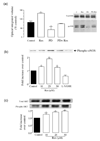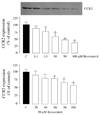Resveratrol inhibits expression and binding activity of the monocyte chemotactic protein-1 receptor, CCR2, on THP-1 monocytes
- PMID: 17499741
- PMCID: PMC2231518
- DOI: 10.1016/j.atherosclerosis.2007.03.039
Resveratrol inhibits expression and binding activity of the monocyte chemotactic protein-1 receptor, CCR2, on THP-1 monocytes
Abstract
Monocyte chemotactic protein-1 and its receptor, CCR2, play a key role in atherosclerosis. We determined the effect of the polyphenol, resveratrol, on CCR2 and the mechanisms involved. Resveratrol treatment inhibited 125I-MCP-1 binding to THP-1 cells; 31, 56, 84% decrease for 10, 50 and 100 microM resveratrol, in the absence of any effect on receptor affinity. The inhibitory effect of resveratrol on 125I-MCP-1 binding to THP-1 cells and on CCR2 protein expression determined by FACS analysis was attenuated by treatment with L-NAME (NOS inhibitor), PD98059 (MAPK inhibitor) and LY294002 (PI3K inhibitor), whereas neither X/XO (reactive oxygen species generator) nor ICI182780 (estrogen receptor antagonist) had any effect. Concomitant with a decrease in CCR2 protein expression, resveratrol inhibited THP-1 CCR2 mRNA levels, in the absence of any effect on its stability; 26 and 45% inhibition at 10 and 50 microM resveratrol, respectively. This effect was not altered by co-treatment with L-NAME, PD98059 or ICI182780, but was potentiated by LY294002 and X/XO.
Conclusions: Resveratrol inhibits monocyte CCR2 binding activity in an NO-, MAPK- and PI3K-dependent manner, whereas it inhibits CCR2 mRNA in an NO- and MAPK-independent, PI3K-dependent manner. These inhibitory effects of resveratrol on chemokine receptor binding and expression may contribute, in part, to its cardiovascular protective activity in vivo.
Figures








Similar articles
-
Homocysteine stimulates the expression of monocyte chemoattractant protein-1 receptor (CCR2) in human monocytes: possible involvement of oxygen free radicals.Biochem J. 2001 Jul 1;357(Pt 1):233-40. doi: 10.1042/0264-6021:3570233. Biochem J. 2001. PMID: 11415454 Free PMC article.
-
p38 MAPK and ERK activation by 9-cis-retinoic acid induces chemokine receptors CCR1 and CCR2 expression in human monocytic THP-1 cells.Exp Mol Med. 2007 Apr 30;39(2):129-38. doi: 10.1038/emm.2007.15. Exp Mol Med. 2007. PMID: 17464174
-
Cilostazol reduces MCP-1-induced chemotaxis and adhesion of THP-1 monocytes by inhibiting CCR2 gene expression.Biochem Biophys Res Commun. 2011 Jul 29;411(2):402-8. doi: 10.1016/j.bbrc.2011.06.163. Epub 2011 Jul 2. Biochem Biophys Res Commun. 2011. PMID: 21756880
-
Monocyte subtypes and the CCR2 chemokine receptor in cardiovascular disease.Clin Sci (Lond). 2017 Jun 1;131(12):1215-1224. doi: 10.1042/CS20170009. Clin Sci (Lond). 2017. PMID: 28566450 Review.
-
MCP-1 and CCR2 in HIV infection: regulation of agonist and receptor expression.J Leukoc Biol. 1997 Jul;62(1):30-3. doi: 10.1002/jlb.62.1.30. J Leukoc Biol. 1997. PMID: 9225989 Review.
Cited by
-
Resveratrol reduces the inflammatory response in adipose tissue and improves adipose insulin signaling in high-fat diet-fed mice.PeerJ. 2018 Jun 29;6:e5173. doi: 10.7717/peerj.5173. eCollection 2018. PeerJ. 2018. PMID: 29967759 Free PMC article.
-
Phytochemical Compounds and Protection from Cardiovascular Diseases: A State of the Art.Biomed Res Int. 2015;2015:918069. doi: 10.1155/2015/918069. Epub 2015 Oct 4. Biomed Res Int. 2015. PMID: 26504846 Free PMC article. Review.
-
Enhanced Endothelialization Using Resveratrol-Loaded Polylactic Acid-Coated Left Atrial Appendage Occluders in a Canine Model.ACS Appl Bio Mater. 2025 Jan 20;8(1):199-207. doi: 10.1021/acsabm.4c01005. Epub 2025 Jan 8. ACS Appl Bio Mater. 2025. PMID: 39779462 Free PMC article.
-
Effect of lignin-derived lignophenols on vascular oxidative stress and inflammation in streptozotocin-induced diabetic rats.Mol Cell Biochem. 2011 Feb;348(1-2):117-24. doi: 10.1007/s11010-010-0645-9. Epub 2010 Nov 10. Mol Cell Biochem. 2011. PMID: 21063899
-
Resveratrol inhibits inflammation induced by heat-killed Listeria monocytogenes.J Med Food. 2012 Sep;15(9):788-94. doi: 10.1089/jmf.2012.2194. Epub 2012 Aug 2. J Med Food. 2012. PMID: 22857612 Free PMC article.
References
-
- Klatsky AL, Armstrong MA, Friedman GD. Alcohol and mortality. Ann. Int. Med. 1992;117:646–654. - PubMed
-
- Klatsky AL, Armstrong MA. Alcoholic beverage choice and risk of coronary heart disease mortality: do red wine drinkers fair best? Am. J. Cardiol. 1993;71:467–469. - PubMed
-
- Demrow HS, Slane PR, Folts JD. Administration of wine and grape juice inhibits in vivo platelet activity and thrombosis in stenosed canine coronary arteries. Circulation. 1995;91:1182–1188. - PubMed
-
- Frankel EN, Kanner J, German JB, Parks E, Kinsella JE. Inhibition of oxidation of human low-density lipoprotein by phenolic substances in red wine. Lancet. 1993;341:454–457. - PubMed
-
- Bavaresco L, Fregoni C, Cantu E, Trevisan M. Stilbene compounds: from the grapevine to wine. Drug Exp. Clin. Res. 1999;25:57–63. - PubMed
Publication types
MeSH terms
Substances
Grants and funding
LinkOut - more resources
Full Text Sources
Research Materials
Miscellaneous

